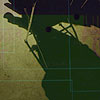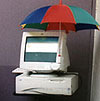 In
contemplating
Garret
Lynch's
posting
of
Sat
Nov
15,
2003:
In
contemplating
Garret
Lynch's
posting
of
Sat
Nov
15,
2003:During the research for a lecture I was giving last week on the topic of "identity in non-places," I came across this mildly amusing website: nonplace.com. Surely all websites (places) are non-places in the blatantly obvious Cartesian sense, although not necessarily in the cultural sense?
My main cause for concern was the creators 'need' of this space to copyright it, although culturally this does follow the lead of 'real' world non-places (spaces)--i.e. fast food chains, supermarkets, etc.
I have been intrigued by a particular question concerning the impulse towards realizing or objectifying the intangible as a means to ownership, intellectual or actual.
While the net has engendered a certain comfort with the decentralization of authorship, or as some would word it, its "death," it has not reconciled the urge to present attachment to a project, even if that attachment is mediated through the apparent impartiality of a pseudonym, collective, or program.
What is the distinction between authorship and ownership? Is it a necessary distinction? How would such a distinction impact the practice of producing and distributing nonentity content? Is the notion of ownership culturally specific, even in the wake of globalization? What are the human factors that encourage the need to own? What is ownership?
These are but a few of my questions. But then again, isn't a question too large for any one person?
:: Lora McPhail ::
 Originally
published
on
12/06/03
Originally
published
on
12/06/03
Short interview with Michiel Knaven.
Michiel Knaven is a Dutch multimedia artist whose core work is made for the Internet and plays an important part in the net-art community. His work stands out from other net art because of his artisan-like style of working, which is rooted in his practice as creator and editor of artists' books.
Peter Luining: From reading your site, I understand that you started in the early 90's by doing artists' books in small volumes. And that made me wonder, what attracted you to the Internet?
Michiel Knaven: I bought my first PC to find out what it would mean for my photography, assemblages and artists' books I was making at that time. Director (version 5) from Macromedia was the program that suited my needs for combining image and sound. And shockwave made it "easy" to put it on the Net. The Net gave me the possibility to share my work and I was able to reach much more people then in the traditional exhibition circuit.
PL: Besides net art and artists' books, you also do installations. How do they fit into all this?
MK: The last installation I built, Canon (2003), was the direct result of a series of streaming net movies I was working on called 'short movie clips.' These movies are programmed in Director; no video is used; and they’re triggered by sound collages. They're real time-based works. Canon is the final piece of the polyphonic chronicle series in which I explore the relation between image and sound in various ways. Sometimes an installation is the counterpart of a net-art piece, like in Leonardo's flight. I first made the net-art piece but then thought later on that there had to be a "real" work, too.
Leonardo's flight II became an interactive installation reacting on the movement of the viewer. So, for me, there are no real differences between installations and net-art pieces; the difference is the use of form and the impact this has on the way you experience the piece. For example, if you beam a net-art piece on a large screen, it will have a completely different impact on the viewer and will become something different from the original work. I like to play with those things.
PL: You talk about the differences of experience when something is shown large (beam) or small (computer screen). When you put your work on the net, you have no control over how people watch your work (large or small monitor, sound or no sound, etc). What do you think of this uncontrollable aspect of your work and net art in general?
MK: The only thing I can do is present the pieces in such ways as to make it clear to the viewer/listener what they need to have on there pc and where to get it. When they, for example, don't have their audio switched on, they'll miss 90% of the piece. It's a pity but there's nothing I can do about it. The charm of net art lies in the fact that it has a one-to-one relation with the viewer, like reading a novel: it's you and the work--alone--which provides a form of intimacy that I think is essential to net art.
PL: With your installations you seem to get loose from the network. Is this a tendency in your work, a sidestep, or just experiments? And how do you see the development of your work in the (near) future?
MK: Net art will always be an important part of my work but you never know how things will develop. I see it as one big adventure, of which I don't yet want to know the ending. For the current project, plaatselijkgeluid.nl (in English localsound.nl), I'm working with eight actors to create soundscapes. This gives me lots of new impulses and will surely affect my future work. And, a new project is in preparation. It will be realized during my upcoming stay in New York (working title: "Hotel Eden").
http://www.michaelmedia.org
::Peter Luining::
 Originally
published
on
12/01/03
Dicshunary.com
is
a
project
I've
been
observing
for
quite
some
time
now
and
it
has
gone
through
various
incarnations.
Originally
published
on
12/01/03
Dicshunary.com
is
a
project
I've
been
observing
for
quite
some
time
now
and
it
has
gone
through
various
incarnations.Working on the edge of language to provide a system of documenting words that evolve as rapidly as the computer culture that uses them, Dicshunary "aims to provide a home for all the small, endangered words that might only exist in the language of one specific neighborhood, family, or person" and never quite make it to dictionaries for one reason or another.
Revolutionary redefinition of languages or redundant codification of content? You decide!
From May 24th to June 17th of 2002, Dicshunary was installed in Waterman's gallery in Brentford. The words in this category were automatically added whenever someone in the gallery added a word
:: Garrett Lynch ::